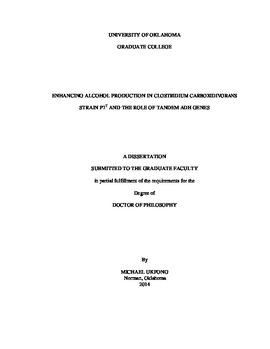| dc.description.abstract | Clostridium carboxidivorans P7 is one of three microbial catalysts capable of fermenting synthesis gas (mainly CO, CO2 and H2) to produce the liquid biofuels ethanol and butanol. Gasification of feedstocks to produce synthesis gas (syngas), followed by microbial conversion to solvents, greatly expands the diversity of suitable feedstocks that can be used for biofuel production beyond commonly used food and energy crops to include agricultural, industrial and municipal waste streams. C. carboxidivorans P7 uses a variation of the classic Wood-Ljungdahl pathway, identified through genome sequence-enabled approaches but only limited direct metabolic analyses. As a result, little is known about gene expression and enzyme activities during solvent production. In this study, we measured cell growth, gene expression, enzyme activity and product formation in autotrophic batch cultures continuously fed a synthetic syngas mixture. These cultures exhibited an initial phase of growth, followed by acidogenesis that resulted in a reduction in pH. After cessation of growth, solventogenesis occurred, pH increased and maximum concentrations of acetate (41 mM), butyrate (1.4 mM), ethanol (61 mM) and butanol (7.1 mM) were achieved. Enzyme activities were highest during the growth phase, but expression of carbon monoxide dehydrogenase, Fe-only hydrogenases and two tandem bi-functional acetaldehyde/alcohol dehydrogenases were highest during specific stages of solventogenesis. Several amino acid substitutions between the tandem acetaldehyde/alcohol dehydrogenases and the differential expression of their genes suggest that they may have different roles during solvent formation. The data presented here provides a link between the expression of key enzymes, their measured activities and solvent production by C. carboxidivorans P7. This research also identifies potential targets for metabolic engineering efforts designed to produce higher amounts of ethanol or butanol from syngas. | en_US |
